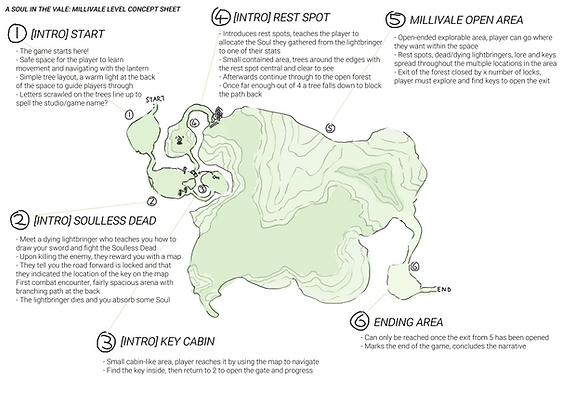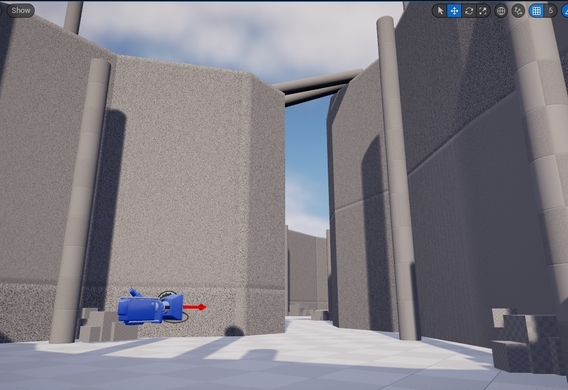
A Soul in the Vale
Platform: Windows PC
Engine: Unreal Engine 5
Language: Unreal Blueprints (Visual Coding)
Tools Used: Unreal Development Kit, Meta Quest 2 VR Headset
Duration: 9 months (2022 --> 2023)
Team Size: 7
Project Design Goals:
- Build an immersive VR horror experience that encourages player exploration.
- Create an expansive 3D level to explore with strong use of lighting to guide players.
Roles: Level Design, Systems Design, Programming (Blueprints),
Production
A Soul in the Vale is a professional project from my second year at university. It is a VR horror game wherein you explore a dark forest known as Miliavale with nothing but a sword and a lantern to light your way. As a young knight, it is your mission to search the woodland for a set of journals belonging to an ancient scholar, and to put an end to an undead ritual spawning a legion of soulless undead.
Gameplay revolves around the use of the player's lantern, which is not only used to light their way through the dark forest, but also reveals invisible enemies that are lurking in the level.
Available here: https://leakyroofstudios.itch.io/a-soul-in-the-vale
Design Document: Available here!
Read here for a look into the specific intent behind A Soul in the Vale, and a thorough explanation of the design that went into the project! A simplified version of the document was made internally for members of the team who struggled with long-form reading: available here!
At the beginning of the game's 9-month development, I worked as a systems and level designer, as well as the team sprint leader. I had a large hand in defining several major game mechanics, such as the lantern revealing invisible enemies, and the 'weak-point' system where players must aim for specific points on an enemy, discouraging mindless flailing of their weapon.
I worked on internal design documents (such as those linked above) and one-page explanations of different aspects of the game, such as an explanation of the layout and pacing of the game's main level. I also worked on constructing the level in-engine; I specifically was responsible for greyboxing and iterating on the opening section of the game, where the player starts and travels through a more linear onboarding area before being set loose into the open-ended level space.
I applied what I learned about 3D level design and lighting from A Tale or Two in the first year to the level, using strings of lights and landmarks to help guide players through the opening of the level.
A little before halfway through development, the team underwent some struggle; several members of the team were leaving university, including most of the people who were familiar with working in Unreal Engine and in VR. The project was too far along to pivot, but as it stood the remaining team would not be able to make a satisfactory version of the game in time for the deadline.
At this stage, I assumed more of a producer role in the team, helping us scope down the project to something we thought we could achieve with our skillset, and reallocating work in a way that would help improve our workflow and overall efficiency.


My transition into production was a smooth one, as my work as the team's sprint leader and drive to collaborate meant I was already working quite closely with other specialisms during the project.
Level design work transferred to another designer, as I shifted to work as a programmer with Unreal's Blueprints, to match the new imbalance of specialisms in the team. I also led playtesting sessions, where I took notes on interesting player behaviours and identified areas to streamline and improve in the level design.
This project helped me push my adaptability as a developer, having me work on multiple different areas of the game, from documentation to level design to coding systems in-engine and so on. My help managing the team's workload and continuously assessing scope meant that we were able to keep up a consistent level of efficiency. While development on A Soul in the Vale was difficult, due to losing some key members of the team partway through, we were still able to release a complete game by the end of the 9 months.







